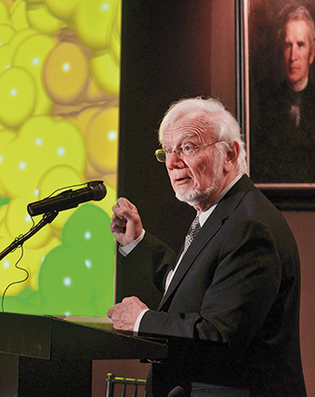 loading
loading
MilestonesThe man who mapped our cellsChemist Thomas Steitz helped unlock the mysteries of the ribosome.  Michael MarslandNobel Prize–winning chemist Thomas Steitz died in October. View full imageThomas A. Steitz, Sterling Professor of Molecular Biophysics and Biochemistry at Yale and a corecipient of the 2009 Nobel Prize in Chemistry, died of pancreatic cancer on October 9. He was 78. Over the course of his career, Steitz detailed the molecular scaffolding of one of biology’s most fundamental processes, the so-called central dogma: genetic information is transmitted from DNA to RNA, and RNA to proteins. As Steitz worked down the chain of operation he ultimately began investigation on a very large molecule known as the ribosome, which marks the last step in the dogma; ribosomes construct proteins by ‘reading’ RNA. After five years of investigation, Steitz and his coworkers published two groundbreaking articles that precisely mapped the position of most of the 120,000 atoms constituting the larger of the ribosome’s two subunits. This work gave unprecedented insight into the ribosome’s function and eventually led to Steitz’s Nobel Prize. His study of the ribosome was also, according to friend and colleague Peter Moore, “only the most conspicuous of the many landmark structures” for which Steitz provided blueprints. Another colleague, Donald Engelman, told the New York Times that Steitz “could have been given three Nobels.” Born in Milwaukee, Steitz attended Lawrence College on full scholarship and majored in chemistry. In his first year of graduate school at Harvard, he attended a lecture in a crowded auditorium in which the audience, with blue-and-red stereo glasses, viewed in three dimensions and on a massive scale the atomic structure of myoglobin. In telling this story, Steitz often described the collective gasp of the audience upon seeing the image. He was sold: from that moment, he committed himself wholly and brilliantly to understanding the three-dimensional atomic structure of biological molecules. Steitz was married for 52 years to Joan Steitz, who survives him and who is also a Sterling Professor of Biophysics and Biochemistry. They joined the Yale faculty together in 1970.
|
|
1 comment
-

Charlie Walls, 11:02am November 05 2018 |  Flag as inappropriate
Flag as inappropriate
The comment period has expired.He certainly didn't "map our cells" and the ribosome is not "a very large molecule," which you then admit is composed of two parts. Each of these two parts is composed of several molecules, being both RNA and proteins. Hence, the work revealed much about how RNA and proteins bind together and RNA can function. Cells are quite enormous compared to ribosomes, which appear as dots in an electron micrograph of a cell cross section. And the fact that RNA is fundamental to this component for protein expression supports the idea of an "RNA world" long, long ago when life's processes were first sorting themselves out. Like the continuity between birds and dinosaurs, only much longer, this ribosome thing only recently worked out in detail goes way back.